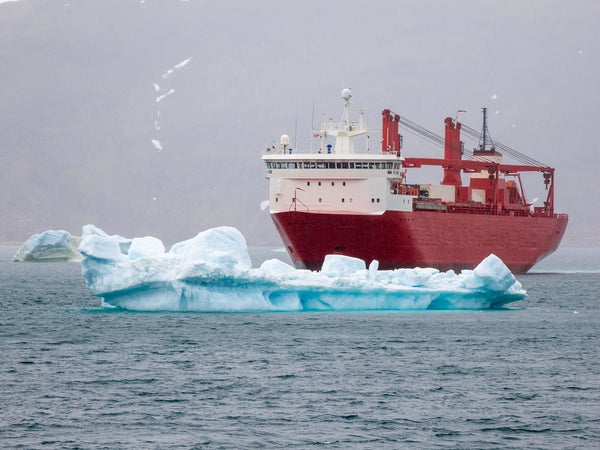January 13, 2025
4 min read
Why Does Greenland Interest Trump? Climate Change Is Only Part of the Story
Arctic shipping routes and burgeoning mining opportunities may be part of Greenland’s appeal to President-elect Donald Trump, but each comes with challenges as well

Container ship navigating among icebergs in the harbor of Narsaq, Southern Greenland.
President-elect Donald Trump has been talking covetously about Greenland, the world’s largest island, among other locations. “Greenland is an incredible place, and the people will benefit tremendously if, and when, it becomes part of our Nation,” he wrote on January 6 on the social media network he founded, Truth Social.
The remarks came out of the blue for many Americans—and Greenlanders as well, according to Kuupik Kleist, former prime minister of the island. “We don’t really know what the background is,” he says. But science offers some hints as to Trump’s motivation—particularly whether it rests on potential ice melt and other results of the warming climate, a phenomenon Trump falsely denies is occurring or is linked to human activities.
First, some background: Greenland is home to fewer than 58,000 people, about one tenth the population of Wyoming, the state with the fewest residents, or just a few thousand more people than those in the U.S. territory of the Northern Mariana Islands. Formerly a colony of Denmark, Greenland is now domestically self-governing but still under Danish control regarding issues such as financial policy, foreign affairs and security.
On supporting science journalism
If you’re enjoying this article, consider supporting our award-winning journalism by subscribing. By purchasing a subscription you are helping to ensure the future of impactful stories about the discoveries and ideas shaping our world today.
And those issues are becoming more intricate as climate change accelerates, making the Arctic a center of global attention. Greenland “is in a very strategic place in the Arctic for many different interests,” says Melody Brown Burkins, who works on science policy and diplomacy in the Arctic and globally at Dartmouth College.
Perhaps the most cited aspect of this strategic location comes from an unglamourous source: international shipping routes. As Arctic ice melts, the argument goes, the region will become more passable to ships, offering shorter routes for moving cargo between population centers. And indeed, that trend seems to be in motion: the number of unique ships entering the Arctic increased by 37 percent between 2013 and 2023, according to the intergovernmental Arctic Council.
But the promise of polar routes may be overhyped, Burkins says. “I think this massive idea that we’re going to send all ships to these new routes to save money is a little odd,” she says, particularly given how harsh polar ocean conditions are and will continue to be. “You can say there’s going to be less ice, but there’s going to be a lot more ice drifting around to puncture ships,” she says.
In September 2023, when Arctic sea ice was at its yearly minimum, fewer than 1,800 individual vessels ventured into the region. That’s less than 2 percent of the global fleet and 63 percent of the whole year’s Arctic ship traffic. Moreover, throughout the year, fishing ships outnumbered cargo ships. Combined, those numbers suggest that despite recent growth in Arctic shipping, the opportunities remain limited, as Burkins suggests. “The seasons are not conducive, and it’s very challenging waters,” she says of these northerly seas, also noting that shipping infrastructure, such as the presence of ports, remains scarce in the region.
That limited infrastructure also complicates the second narrative that has often been cited as a reason for interest in Greenland: mineral extraction, says Anne Merrild, a professor of resource management at Aalborg University in Denmark, who grew up in Greenland. The minerals that are so desirable are rich in rare earth metals and other materials that could be particularly useful in renewable energy technology such as power-storing batteries and windmill magnets.
Merrild notes, however, that those minerals are not, as outsiders might assume, buried under Greenland’s ice sheet and frozen out of the reach of would-be miners. Plenty lie along the ice-free coasts—but firmly underground, awaiting export infrastructure, Greenlandic political will and foreign commercial partnerships. Despite Trump’s comments, Merrild says that her research hasn’t shown much U.S. commercial interest in the island’s minerals. Nevertheless, she and Kleist believe that under the right conditions, Greenlanders would be willing to permit mining as a way of diversifying its economy beyond fishing.
“Each of these is fraught,” Burkins says of shipping lanes and rare earth mining, as well as other explanations for Trump’s interest in annexing another government’s land. If national security is the concern, since the mid-20th century the U.S. has had rights to operate military outposts in Greenland. Such outposts have included an infamous would-be ballistic missile site that was abandoned in 1966, produced more than 47,000 gallons of radioactive waste and is still buried under the ice sheet, as well as a single Space Force base operating today.
Greenland may not often be considered powerful, but it has real political ties with both Denmark and the rest of Europe, as well as long historical connections with Canada. Trump’s apparent interest in the island may even give Greenlanders additional leverage in these international conversations, Merrild speculates.
And while Greenland and Denmark are in ongoing discussions of potential independence for the island, it’s hard to imagine Greenlanders finally breaking ties with one colonial power only to voluntarily accept another—making Trump’s threats to use economic or military force particularly problematic, Kleist says. “That’s far beyond acceptable,” he says. “You don’t simply do that in 2025.”

